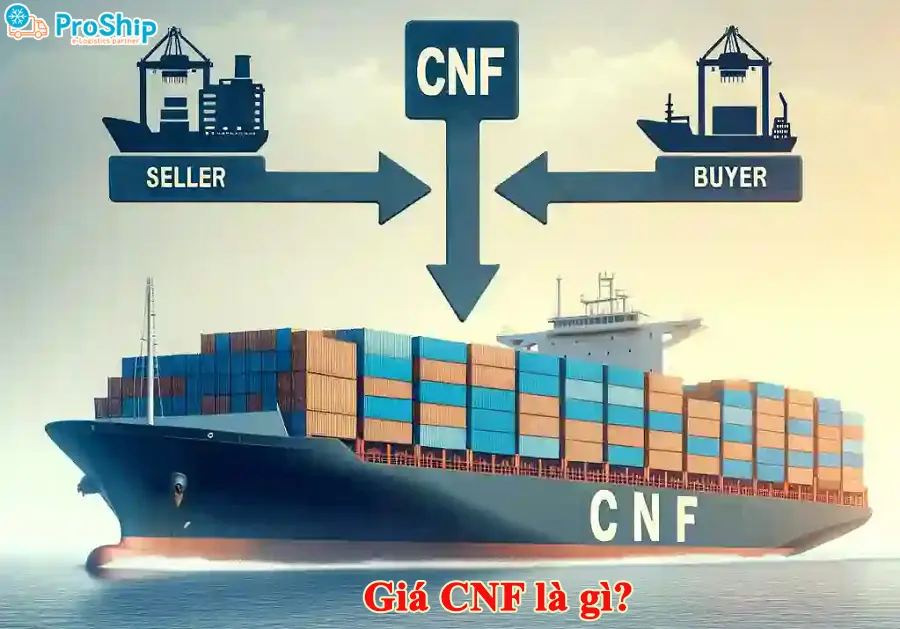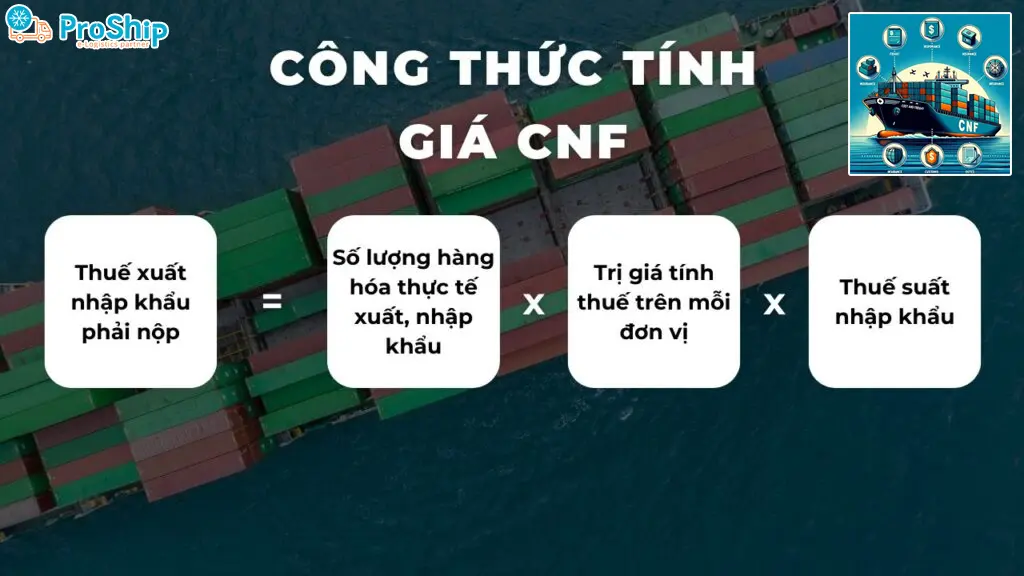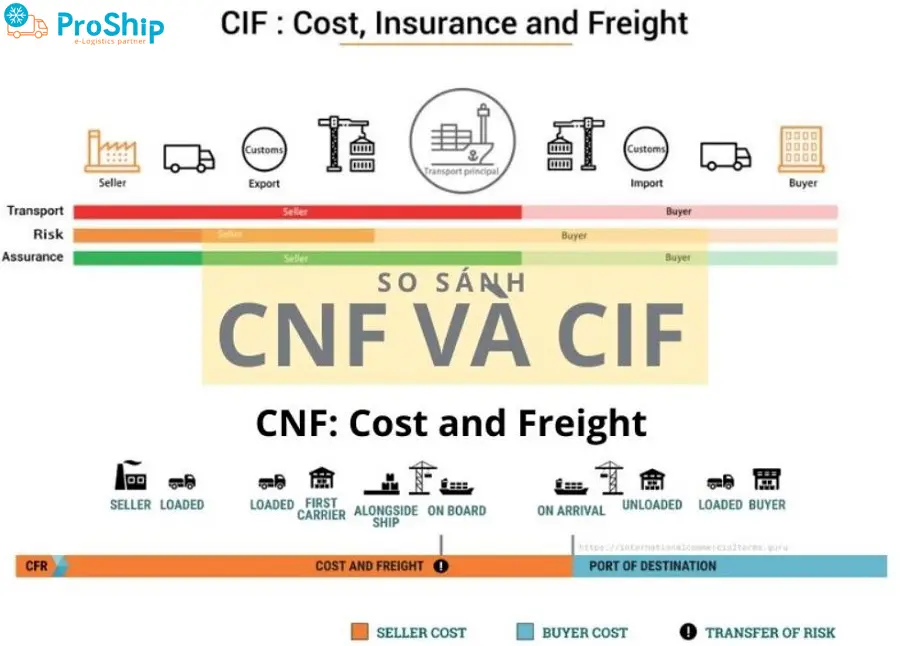x Bạn đang tham gia vào các giao dịch, buôn bán, giao thương quốc tế và thắc mắc giá CNF là gì, quy định ra sao? Khi nào nên sử dụng điều kiện CNF?
x Bạn muốn biết yếu tố nào ảnh hưởng tới phí CNF? Cách tính CNF ra sao?
x Bạn muốn biết khi sử dụng điều kiện CNF có cần lưu ý gì không…?
Proship.vn chúng tôi sẽ giải đáp giá CNF là gì? Cách tính CNF như thế nào? Các bên liên quan có trách nhiệm và nghĩa vụ gì khi tham gia trong điều kiện CNF? Cần lưu ý gì khi sử dụng CNF,…tất cả sẽ được làm rõ ngay sau đây.
Giá CNF là gì? Khi nào nên sử dụng CNF?
Bên bán, bên mua trong các giao dịch thương mại quốc tế thắc mắc về giá CNF và khi nào nên sử dụng. Cùng Proship đi tìm câu trả lời nhé:
Giá CNF là gì?
CNF viết tắt của Cost & Freight, là chi phí và vận chuyển hàng hóa. Là một loại thỏa thuận được sử dụng trong ngành về việc vận chuyển hàng hóa giữa người bán và người mua. Trong đó, người bán sẽ chịu trách nhiệm trả tiền vận chuyển hàng hóa tới cảng bên mua (chi phí không bao gồm phí bảo hiểm). Đồng thời, bên bán chịu trách nhiệm về rủi ro hàng hóa trước khi giao lên tàu.
Giá CNF (Cost and Freight) bao gồm tiền hàng và cước vận chuyển hàng hóa đến cảng đích. Sau khi hàng được giao cho lên tàu, trách nhiệm rủi ro hàng hóa được chuyển giao sang người mua.

Khi nào nên sử dụng CNF?
Nên sử dụng điều kiện CNF khi:
* Với người mua:
- Khi mới bắt đầu kinh doanh quốc tế để tránh rắc rối với quy trình vận chuyển hàng hóa;
- Lý tưởng khi nhập khẩu số lượng nhỏ;
- Cần có đại lý vận tải hoặc môi giới hải quan uy tín tại cảng nhập để hỗ trợ.
* Với người bán:
- Sử dụng CNF có thể tăng lợi nhuận do giá bán hàng có thể cao hơn;
- Hữu ích cho các giao dịch quốc tế khi người mua không quen với thủ tục nhập khẩu;
- Khi có các đối tác giao nhận và vận chuyển đáng tin cậy, việc áp dụng giá CNF sẽ thuận tiện hơn.
Cách tính giá CNF như thế nào chuẩn nhất?
Cùng Proship tìm hiểu các yếu tố ảnh hưởng phí CNF và cách tính phí CNF:
Yếu tố ảnh hưởng phí CNF
Các yếu tố ảnh hưởng tới chi phí CNF là:
- Giá cả hàng hóa: Là giá trị cơ bản của sản phẩm người bán cung cấp;
- Phí bảo hiểm: Tuy CNF không bắt buộc bảo hiểm nhưng nếu người mua yêu cầu, chi phí bảo hiểm sẽ được tính thêm;
- Phí cảng và thuế: Các khoản phí này thường phát sinh tại cảng xuất khẩu và cảng nhập khẩu;
- Phí vận chuyển: Gồm chi phí để vận chuyển hàng từ kho của người bán đến cảng giao hàng;
- Phụ phí khác: Có thể bao gồm các khoản phí như phí xử lý, phí dịch vụ, phí lưu kho tại cảng,…

Cách tính chi phí CNF
Giá CNF là gì? Giá CNF (Cost and Freight – Chi phí và Cước phí) bao gồm 2 phần phải thanh toán khác nhau, cụ thể:
- C (Cost): Giá của hàng hóa tính theo Hợp đồng ngoại thương.
- F (Freight): Là cước phí vận chuyển hàng đến địa điểm đã được thống nhất từ trước và điểm dỡ hàng theo thỏa thuận Hợp đồng ngoại thương.
Để tính được giá CNF sẽ làm theo công thức sau:
Giá CNF = C (Giá hàng hóa) + F (Cước phí vận chuyển)
Song khi nhập khẩu hàng hóa theo điều kiện giao hàng CNF, người mua (nhà nhập khẩu) cần phải thanh toán thêm các loại thuế và phí khác như:
Thuế nhập khẩu = Số lượng hàng hóa nhập khẩu thực tế x Trị giá tính thuế trên mỗi đơn vị hàng hóa x Thuế suất nhập khẩu
- Phí bảo hiểm;
- Lệ phí thủ tục hải quan;
- Thuế giá trị gia tăng;
- Phí an ninh cảng;
- Phụ phí xăng dầu (nếu có);
- Phí lắp ghép (nếu có);
- Phí lưu kho (nếu có).
Trách nhiệm, nghĩa vụ các bên khi tham gia điều kiện CNF
Giá CNF là gì đã được Proship giải đáp, tiếp theo là trách nhiệm và nghĩa vụ các bên khi tham gia vào điều kiện CNF. Khi mua bán theo điều khoản CNF, người bán và người mua phải đảm bảo các nghĩa vụ và trách nhiệm của mình:
Trách nhiệm, nghĩa vụ người bán trong CNF
Nghĩa vụ và trách nhiệm của người bán:
- Chịu trách nhiệm, rủi ro và chi phí để lấy giấy phép nhập khẩu và chuẩn bị thủ tục hải quan;
- Cung cấp hàng hóa đúng số lượng hợp đồng và các giấy tờ liên quan;
- Ký kết hợp đồng, thanh toán chi phí vận chuyển đường biển, và cung cấp thông tin cần thiết cho bảo hiểm hàng hóa;
- Đảm bảo giao hàng đúng thời gian và trạng thái, chịu trách nhiệm về hàng hóa trước khi xuất khẩu.
Trách nhiệm, nghĩa vụ người mua trong CNF
Nghĩa vụ và trách nhiệm của người mua:
- Chịu trách nhiệm và rủi ro liên quan đến hàng hóa sau khi đã được chuyển lên tàu và khi nhận hàng;
- Thanh toán các khoản phí theo hợp đồng, bao gồm phí vận chuyển và lưu trữ hàng hóa trước khi giao hàng lên tàu;
- Cung cấp thông tin vận chuyển và chịu chi phí liên quan đến việc nhận hàng và thủ tục nhập khẩu;
- Chịu rủi ro và chi phí để lấy giấy phép nhập khẩu, cung cấp thông tin cần thiết và nhận hàng đúng thời điểm.
Lưu ý khi sử dụng điều kiện CNF trong thương mại quốc tế
Khi tham gia vào các giao dịch thương mại quốc tế sử dụng điều kiện CNF, các doanh nghiệp cần chú ý đến một số điểm sau:
Thông tin rõ ràng
Đảm bảo rằng mọi thông tin liên quan đến giao dịch, như thời gian giao hàng, cảng đích, và các chi phí khác, được ghi rõ ràng trong hợp đồng.
Rủi ro chuyển giao
Dù người bán chịu trách nhiệm vận chuyển hàng hóa đến cảng đích, rủi ro chuyển giao từ người bán sang người mua ngay khi hàng hóa được giao cho người vận chuyển tại cảng xuất khẩu. Doanh nghiệp cần xác định rõ thời điểm này để tránh mất mát hoặc hư hỏng.
Chi phí bất ngờ
CNF bao gồm chi phí và cước vận chuyển nhưng không gồm bảo hiểm hoặc các chi phí khác tại cảng đích. Doanh nghiệp cần lưu ý và dự đoán các chi phí này.
So sánh điểm giống, khác nhau giữa giá CNF và giá CFR
Điểm giống, khác nhau giữa giá CPT và giá CNF là gì? Proship chỉ ra như sau:
Điểm giống nhau giữa CNF và CPT
Điều kiện CFR và CPT đều đặt người bán thuê tàu hoặc phương tiện vận chuyển đến điểm đích nằm ở bên nước của người mua.
Trong cả hai trường hợp, rủi ro với hàng hóa trên biển được gánh cho người mua. CFR và CPT đều đặt nghĩa vụ thông quan hàng hóa ở cả hai đầu và đều gánh chi phí bốc dỡ hàng hóa ở hai đầu.

Điểm khác nhau giữa CNF và CPT
Ngoài điểm giống nhau thì giữa CFR và CPT còn có điểm khác nhau sau:
| CNF | CPT |
| Dùng cho đường biển và thủy nội địa. | Dùng cho mọi hình thức – chủ yếu là đường biển và đường bay. |
| Bên người bán chỉ hết trách nhiệm khi hàng nằm trên tàu. | Bên người bán hết trách nhiệm khi giao hàng cho người chuyên chở (người bán sẽ hết trách nhiệm khi đến địa điểm người chuyên chở yêu cầu). |
Giá CNF là gì cùng quy định về trách nhiệm, nghĩa vụ của bên bán và bên mua khi tham gia vào điều kiện Cost & Freight đã được chia sẻ bởi Proship. Song song đó, các bên liên quan cũng cần nắm rõ về các yếu tố tác động cũng như cách tính phí CNF ra sao để thuận tiện trong các giao dịch thương mại quốc tế. Mọi thắc mắc, liên hệ ngay 0909 344 247 để được giải đáp.

